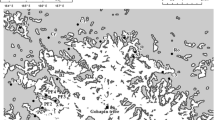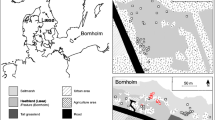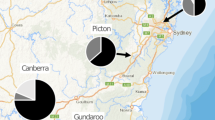Abstract
Social Hymenoptera have been relatively little studied in terms of conservation genetics even though their sociality and complementary sex determination potentially influence the interaction of genetics with extinction risk. Using microsatellite markers, we investigated the social and genetic structure of nests and populations of the Black Bog Ant Formica picea at four sites in the UK, where this habitat specialist has a localized and fragmented range. Nests were weakly polygynous (effective queen number, 4–27 per nest) with low worker relatedness. Isolation by distance tended to be present within sites, indicating limited dispersal, but inbreeding was rare. The four study sites fell into three main populations (two in South Wales, one in southern England). We conclude that, although UK F. picea populations are not at immediate risk from genetic factors, their limited dispersal abilities at both within- and between-site scales should inform conservation management decisions.



Similar content being viewed by others
References
Bolton B, Collingwood CA (1975) Handbooks for the identification of British insects: Hymenoptera Formicidae. Royal Entomological Society of London, London
Bourke AFG, Franks NR (1995) Social evolution in ants. Princeton University Press, Princeton
Chapman RE, Bourke AFG (2001) The influence of sociality on the conservation biology of social insects. Ecol Lett 4:650–662. doi:10.1046/j.1461-0248.2001.00253.x
Chapuisat M (1996) Characterization of microsatellite loci in Formica lugubris B and their variability in other ant species. Mol Ecol 5:599–601. doi:10.1111/j.1365-294X.1996.tb00354.x
Chapuisat M, Bocherens S, Rosset H (2004) Variable queen number in ant colonies: no impact on queen turnover, inbreeding, and population genetic differentiation in the ant Formica selysi. Evol Int J Org Evol 58:1064–1072
Cornuet JM, Luikart G (1996) Description and power analysis of two tests for detecting recent population bottlenecks from allele frequency data. Genetics 144:2001–2014
Czechowski W, Radchenko A, Czechowska W (2002) The ants (Hymenoptera, Formicidae) of Poland. Museum and Institute of Zoology PAS, Warsaw
Darvill B, Ellis JS, Lye GC, Goulson D (2006) Population structure and inbreeding in a rare and declining bumblebee, Bombus muscorum (Hymenoptera: Apidae). Mol Ecol 15:601–611. doi:10.1111/j.1365-294X.2006.02797.x
DeHeer CJ, Herbers JM (2004) Population genetics of the socially polymorphic ant Formica podzolica. Insectes Soc 51:309–316. doi:10.1007/s00040-004-0745-1
Dirienzo A, Peterson AC, Garza JC, Valdes AM, Slatkin M, Freimer NB (1994) Mutational processes of simple sequence repeat loci in human populations. Proc Natl Acad Sci USA 91:3166–3170. doi:10.1073/pnas.91.8.3166
Donisthorpe HSJK (1927) British ants, 2nd edn. George Routledge and Sons Ltd., London
Ellis JS, Knight ME, Darvill B, Goulson D (2006) Extremely low effective population sizes, genetic structuring and reduced genetic diversity in a threatened bumblebee species, Bombus sylvarum (Hymenoptera: Apidae). Mol Ecol 15:4375–4386. doi:10.1111/j.1365-294X.2006.03121.x
Evanno G, Regnaut S, Goudet J (2005) Detecting the number of clusters of individuals using the software STRUCTURE: a simulation study. Mol Ecol 14:2611–2620. doi:10.1111/j.1365-294X.2005.02553.x
Falk S (1991) A review of the scarce and threatened bees, wasps and ants of Great Britain. Nature Conservancy Council, Peterborough
Falush D, Stephens M, Pritchard JK (2003) Inference of population structure using multilocus genotype data: linked loci and correlated allele frequencies. Genetics 164:1567–1587
Frankham R, Ballou JD, Briscoe DA (2002) Introduction to conservation genetics. Cambridge University Press, Cambridge
Goropashnaya AV, Seppä P, Pamilo P (2001) Social and genetic characteristics of geographically isolated populations in the ant Formica cinerea. Mol Ecol 10:2807–2818
Goropashnaya AV, Fedorov VB, Seifert B, Pamilo P (2007) Phylogeography and population structure in the ant Formica exsecta (Hymenoptera, Formicidae) across Eurasia as reflected by mitochondrial DNA variation and microsatellites. Ann Zool Fenn 44:462–474
Goulson D, Lye GC, Darvill B (2008) Decline and conservation of bumble bees. Annu Rev Entomol 53:191–208
Gyllenstrand N, Seppä P (2003) Conservation genetics of the wood ant, Formica lugubris, in a fragmented landscape. Mol Ecol 12:2931–2940. doi:10.1046/j.1365-294X.2003.01975.x
Gyllenstrand N, Gertsch PJ, Pamilo P (2002) Polymorphic microsatellite DNA markers in the ant Formica exsecta. Mol Ecol Notes 2:67–69. doi:10.1046/j.1471-8286.2002.00152.x
Gyllenstrand N, Seppä P, Pamilo P (2004) Genetic differentiation in sympatric wood ants, Formica rufa and F. polyctena. Insectes Soc 51:139–145. doi:10.1007/s00040-003-0720-2
Helanterä H, Sundström L (2007) Worker reproduction in Formica ants. Am Nat 170:E14–E25. doi:10.1086/518185
Hoffman JI, Amos W (2005) Microsatellite genotyping errors: detection approaches, common sources and consequences for paternal exclusion. Mol Ecol 14:599–612. doi:10.1111/j.1365-294X.2004.02419.x
Hudson J (2008) The Black Bog Ant Formica picea Nylander, 1846 (=candida) new to Pembrokeshire. Bees, Wasps and Ants Recording Society Newsletter, Spring 2008, pp 6–7
Jakobsson M, Rosenberg NA (2007) CLUMPP: a cluster matching and permutation program for dealing with label switching and multimodality in analysis of population structure. Bioinformatics 23:1801–1806. doi:10.1093/bioinformatics/btm233
Kümmerli R, Keller L (2007) Contrasting population genetic structure for workers and queens in the putatively unicolonial ant Formica exsecta. Mol Ecol 16:4493–4503. doi:10.1111/j.1365-294X.2007.03514.x
Mabelis AA, Chardon JP (2005) Survival of the Black bog ant (Formica transkaucasica Nasanov) in relation to the fragmentation of its habitat. J Insect Conserv 9:95–108. doi:10.1007/s10841-004-5987-8
Mäki-Petäys H, Breen J (2007) Genetic vulnerability of a remnant ant population. Conserv Genet 8:427–435. doi:10.1007/s10592-006-9182-1
Mäki-Petäys H, Zakharov A, Viljakainen L, Corander J, Pamilo P (2005) Genetic changes associated to declining populations of Formica ants in fragmented forest landscape. Mol Ecol 14:733–742. doi:10.1111/j.1365-294X.2005.02444.x
McRae BH, Beier P, Dewald LE, Huynh LY, Keim P (2005) Habitat barriers limit gene flow and illuminate historical events in a wide-ranging carnivore, the American puma. Mol Ecol 14:1965–1977. doi:10.1111/j.1365-294x.2005.02571.x
Pamilo P (1982a) Genetic population structure in polygynous Formica ants. Heredity 48:95–106. doi:10.1038/hdy.1982.10
Pamilo P (1982b) Multiple mating in Formica ants. Hereditas 97:37–45. doi:10.1111/j.1601-5223.1982.tb00709.x
Pamilo P (1983) Genetic differentiation within subdivided populations of Formica ants. Evol Int J Org Evol 37:1010–1022. doi:10.2307/2408415
Pamilo P (1985) Effect of inbreeding on genetic relatedness. Hereditas 103:195–200. doi:10.1111/j.1601-5223.1985.tb00501.x
Pamilo P (1993) Polyandry and allele frequency differences between the sexes in the ant Formica aquilonia. Heredity 70:472–480. doi:10.1038/hdy.1993.69
Pamilo P, Crozier RH (1997) Population biology of social insect conservation. Mem Mus Vict 56:411–419
Pontin J (2005) Ants of Surrey. Surrey Wildlife Trust, Woking
Pritchard JK, Stephens M, Donnelly P (2000) Inference of population structure using multilocus genotype data. Genetics 155:945–959
Queller DC, Goodnight KF (1989) Estimating relatedness using genetic markers. Evol Int J Org Evol 43:258–275. doi:10.2307/2409206
Rees SD (2006) Conservation genetics and ecology of the endangered Black Bog Ant, Formica picea. PhD thesis, Cardiff University, UK
Rice WR (1989) Analyzing tables of statistical tests. Evol Int J Org Evol 43:223–225. doi:10.2307/2409177
Samways MJ (2005) Insect diversity conservation. Cambridge University Press, Cambridge
Seifert B (2004) The ‘Black Bog Ant’ Formica picea Nylander, 1846—a species different from Formica candida Smith, 1878 (Hymenoptera: Formicidae). Myrmecol Nachr 6:29–38
Seppä P (1994) Sociogenetic organization of the ants Myrmica ruginodis and Myrmica lobicornis: number, relatedness and longevity of reproducing individuals. J Evol Biol 7:71–95. doi:10.1046/j.1420-9101.1994.7010071.x
Seppä P, Gyllenstrand N, Corander J, Pamilo P (2004) Coexistence of the social types: genetic population structure in the ant Formica exsecta. Evol Int J Org Evol 58:2462–2471
Shirt DB (ed) (1987) British red data books, 2. Insects. Nature Conservancy Council, Peterborough
Sundström L, Seppä P, Pamilo P (2005) Genetic population structure and dispersal patterns in Formica ants—a review. Ann Zool Fenn 42:163–177
Zayed A, Packer L (2005) Complementary sex determination substantially increases extinction proneness of haplodiploid populations. Proc Natl Acad Sci USA 102:10742–10746. doi:10.1073/pnas.0502271102
Acknowledgments
We thank Bill Jordan for advice on microsatellite genotyping and two anonymous reviewers for helpful comments. We also thank the following individuals and organizations for collecting advice, providing access to sites, or on-site assistance: Andy Abbott (Abbott Ecology), Tim Brodie-James (English Nature), Graham Elmes (Centre for Ecology and Hydrology), Lin Gander (Wildlife Trust for South and West Wales), Michael Howe (Countryside Council for Wales), Ray North, Sian Musgrave (National Trust), David Sheppard (English Nature), David Stradling (Whitley Wildlife Conservation Trust), Diana Westerhoff (English Nature) and Simon Weymouth (Forestry Commission). Figure 1a was prepared using Alan Morton’s DMAP software. This work was funded by a NERC studentship held by SDR.
Author information
Authors and Affiliations
Corresponding author
Rights and permissions
About this article
Cite this article
Rees, S.D., Orledge, G.M., Bruford, M.W. et al. Genetic structure of the Black Bog Ant (Formica picea Nylander) in the United Kingdom. Conserv Genet 11, 823–834 (2010). https://doi.org/10.1007/s10592-009-9915-z
Received:
Accepted:
Published:
Issue Date:
DOI: https://doi.org/10.1007/s10592-009-9915-z




